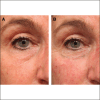Lower Eyelid Dark Circles (Tear Trough and Lid-Cheek Junction): A Stepwise Assessment Framework
- PMID: 38489829
- PMCID: PMC11177555
- DOI: 10.1093/asj/sjae058
Lower Eyelid Dark Circles (Tear Trough and Lid-Cheek Junction): A Stepwise Assessment Framework
Abstract
Background: Despite increasing popularity, the use of hyaluronic acid (HA) fillers for the correction of dark under-eye shadows remains challenging. Specific guidance on patient assessment is limited.
Objectives: The aim of this study was to develop a stepwise assessment framework for lower eyelid dark shadows to help practitioners classify patients based on their underlying problems and facilitate a more strategic approach to treatment.
Methods: Literature review and peer collaboration informed the current availability of educational material for use by experienced injectors when assessing patients presenting with dark circles. A practitioner survey provided insight into current practices. A focus group convened to review the survey results and discuss best practice approaches to patient assessment.
Results: Surveyed practitioners (n = 39) reported patient concern about under-eye hollows (91%), dark eye circles (80%), and looking tired (60%). All (100%) agreed that midcheek volume was critical when treating tear-trough depression, and only 26% reported use of a tear-trough classification system. The focus group developed a framework for assessing tear-trough depression and the lid-cheek junction in patients presenting with dark circles. Key factors within this framework included the importance of appropriate lighting when conducting a visual inspection, regional inspection of the cheek and tear trough, palpation of the orbital rim and soft tissues, determination of the orbital vector, and assessment of lower eyelid pigmentation and skin quality.
Conclusions: Careful step-by-step assessment can reduce the challenges of treating dark circles by identifying patients in whom dark eye circles may be improved without the need to directly inject filler into the tear trough.
© The Author(s) 2024. Published by Oxford University Press on behalf of The Aesthetic Society.
Figures








References
MeSH terms
Substances
LinkOut - more resources
Full Text Sources
Medical

